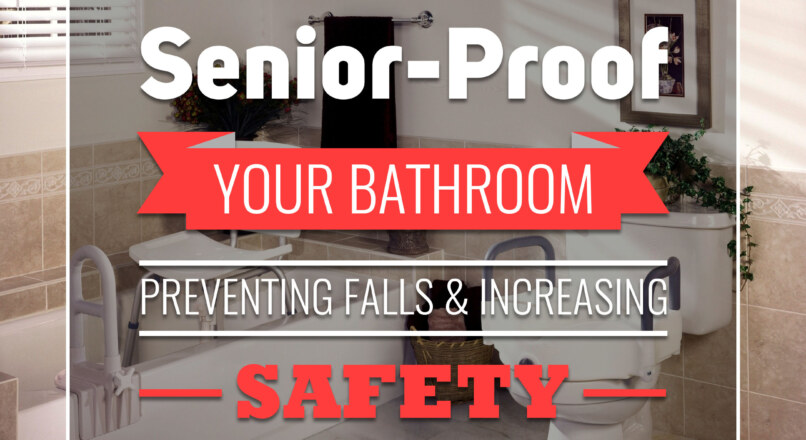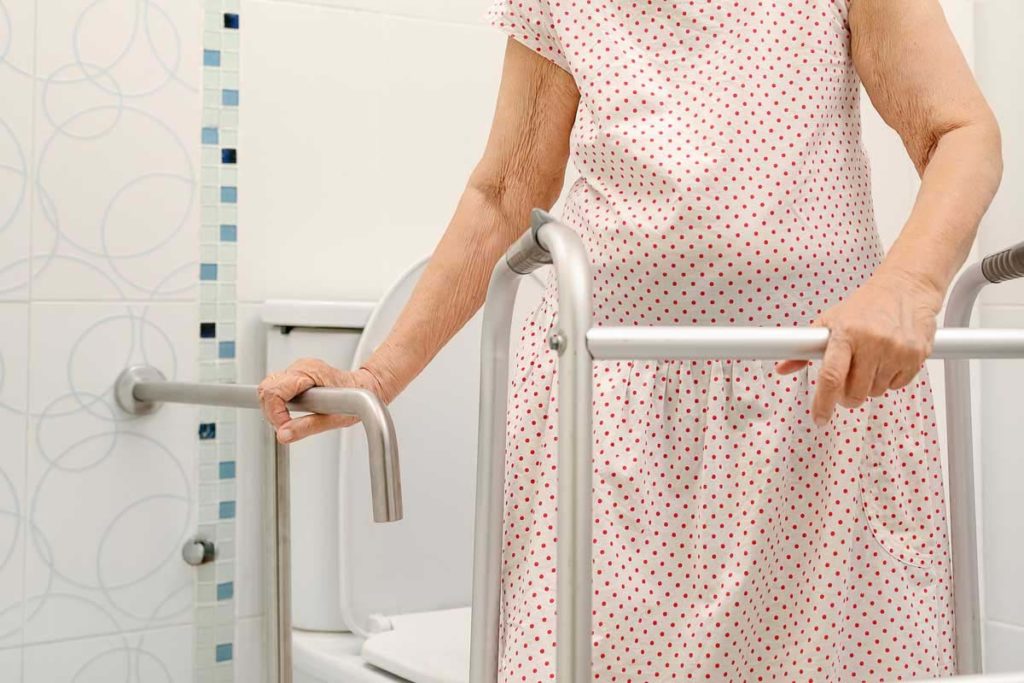
Bathroom Safety for the Elderly: Choosing the Right Accessories and Cognitive Strategies To Prevent Falls
For adults over the age of 65, the bathroom can be just about the scariest room in the house. The combination of slippery surfaces and hard edges is a recipe for disaster when an older adult’s balance and coordination are compromised by age, disease, or disorder.
The good news is that most bathroom accidents can be prevented.
There are two goals that older adults and/or their caregivers should keep in mind when it comes to bathroom safety:
1.) Avoiding Falls
2.) Getting Stranded.
Getting stuck on the toilet or in the tub/shower leads to quick and light decisions that can result in a fall or injury. Additionally, getting stranded for a lengthy period of time without assistance can lead to dehydration, malnutrition, or other medical episodes. Loss of balance or full-fledged falls can result in serious injury, hospitalization, and/or death.
There are 3 categories of safety tips that older adults and their caregivers can utilize to enhance bathroom safety and overall bathroom independence: Environmental Modifications, Cognitive Strategies, and Emergency Protocol.
Environmental Modifications:
This includes any equipment needs that could assist someone in using the bathroom in a more safe and effective manner. This doesn’t mean that every elderly individual should run out and buy every piece of adaptive bathroom equipment known on the market. Consult with a medical professional, a medical equipment specialist, or an occupational therapist to see what is right for you:
Shower chair/bath bench:
[amazon fields=”B002VWK0T6″ value=”thumb”]
[amazon link=”B002VWK0T6″ title=”Shower chairs or benches” /] are a great option for those who can only stand for limited amounts of time, have had lower extremity surgeries/injuries, or have a history of slipping in the bathtub or shower.
Toilet riser: [amazon fields=”B002VWK0UK” value=”thumb”]Many doctors recommend [amazon link=”B002VWK0UK” title=”toilet risers for individuals” /] who recently discharged from hip surgery. However, toilet risers are very useful for those who struggle with standing up from lower seats such as toilets.
Grab bars: [amazon fields=”B01G48KSLC” value=”thumb”] Grab bars can be installed professionally throughout the bathroom, preferably by the toilet or in the shower/tub. Medical equipment companies also make [amazon link=”B01G48KSLC” title=”suction grab bars that can be moved and placed anywhere in the shower or tub.” /]
Reaher: [amazon fields=”B00UZHYXHO” value=”thumb”] Guaranteed, something will drop on the floor in the bathroom whether it is a toothbrush or clothing. [amazon link=”B00UZHYXHO” title=”Using a reacher grabber” /] prevents excessive bending and reduces risk for falling forward.
Non-slip mats: [amazon fields=”B07B9RFQBJ” value=”thumb”][amazon link=”B07B9RFQBJ” title=”Non-slip mats can be placed in the tub, shower, and anywhere on the bathroom floor.” /] Make sure that any non-slip mat you decide to purchase has non-slip features on both sides.
Night-lights: [amazon fields=”B01DLLTDLG” value=”thumb”] Every older adult can say they have made those nightly trips to the bathroom. Make the trip safer by keeping your floors clean and the night lights on. [amazon link=”B01DLLTDLG” title=”Night lights help older individuals” /] see a clear path at night to avoid bumping or knocking things over. Which could lead to some really bad falls.
3-in-1 commodes: [amazon fields=”B0776G7KVQ” value=”thumb”] 3-in-1 commodes can be placed by the bedside, rolled over the toilet, or even rolled into a walk-in shower. [amazon link=”B0776G7KVQ” title=”Having a 3-in-1 shower and bedside commode” /] is a helpful piece of equipment for older individuals who have severely limited mobility.
Fall alarms: Fall alarms with long pull cords can be installed in bathrooms in order to alarm other family members or caregivers in the house when an older adults has had an accident. Phillips Lifeline Alert Systems are also very useful in order to recruit help and emergency response from outside of the house.
Door modifications: If the bathroom door opens inwards, this could potentially block emergency personnel from getting in to help someone who has fallen. Consider modifying the door by either having it swing outward, by replacing it with a pull curtain, or replacing it with a slide door.

Cognitive Strategies:
Some older adults are physically healthy, but experience cognitive decline that negatively impacts their mobility. Persons with dementia and other neurological disorders that change the brain are at very high risk for falls and injury in the bathroom due to decreased safety awareness, impulsivity, and poor judgment. Here are some tips for caregivers:
Fall alarm placement: Place fall alarms in beds, wheelchairs, and recliners to let caregivers know when an older adult has gotten up. This will allow a caregiver to come and assist the individual into the bathroom.
Consistent bathroom use schedules: Attempt to structure a bathroom use schedule for the older adult. This includes toilet use, shower use, basic hygiene, etc. This will help the caregiver know at what time roughly the older adult will attempt to use the bathroom.
Locks: If the older adult has severe cognitive decline but is very mobile, consider locking up hazardous bathroom supplies including razors, scissors, tweezers, files, medicines, lotions, mouthwashes, etc.
Obstacle clearance: Many folks with dementia will still attempt to get up and walk without help no matter the efforts of the caregiver. Make sure to keep hallways and floors clear of obstacles, loose rugs, and small pets.
Emergency Protocol:
For some older adults, it is a matter of WHEN they fall rather than IF they fall. Every older adult living in a private residence should have an emergency plan for when something goes wrong in the bathroom. Create a system that works best for the family. Practice the emergency protocol and frequently check alarms and phone access.
Hopefully, this gives you a way to plan and prepare your family members bathroom to prevent any unforeseen accidents. This way you can rest easy knowing that you have the necessary precautions in place to avoid any accidents.
Where To Buy Bathroom Safety Equipment?
You can shop many places online. However we recommend using Amazon to find most of your bathroom safety equipment due to good pricing. Especially if you have an Amazon Prime Account.
Below are a list of the items we mentioned in our bathroom safety equipment list.
[amazon box=”B002VWK0T6,B002VWK0UK,B01G48KSLC,B00UZHYXHO,B07B9RFQBJ,B01DLLTDLG,B0776G7KVQ,” template=”list”]

Leave a reply